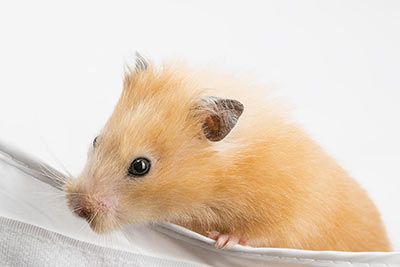Cream Syrian Hamster
Cream Syrian Hamster Breed Profile
| Origin | Syria, Turkey |
| Genus | Mesocricetus |
| Scientific name | Mesocricetus auratus |
| Size | 4.8 to 6.2 inches (12-16 cm) |
| Color | Cream to apricot; black or red eyes |
| Lifespan | 1.5 to 2.5 years |
| Personality | Generally even-tempered, easy to tame |
| How to keep them | Separately |

Characteristics
The cream Syrian hamster is a cultivated kind of Syrian hamster. While the teddy and satin Syrian hamsters have fur that is a different texture and length, the cream Syrian hamster is just a “normal” Syrian hamster with an especially lovely color to its coat. This wasn’t bred, it’s completely natural.
Cream Syrian hamsters are always just one color, without any patches or spots. If they have black eyes, the fur is generally more apricot and the ears dark gray. These are called “back eyed cream”. If they have red eyes, they’re called “red eyed cream”. In this case, their fur will be more ivory.
Hamsters Love Sand Baths
But why? People wash, shower or bathe to get rid of dirt and muck. Hamsters do the same, but with sand instead of water. This is down to two reasons. They can’t swim very well. Water would also wash away important oils from their skin and fur. Without them, their fur would be dull and brittle and their skin would be dry and vulnerable to illness.
As they roll around, the fine sand gets into their dense undercoats, where it removes dirt, fungus and parasites (e.g. mites). Together with the sand, everything that’s not supposed to be in the hamster’s fur falls out. Sand baths also look after their nails. Doesn’t sand get in their ears? This can’t happen to hamsters. They simply close their ears or hold them close to their heads.
The Perfect Sand Bath
Low-dust chinchilla sand is ideal for a lovely hamster bath. You fill a flat bowl with the sand so it doesn’t get all over the cage. Or you can separate off an area of the cage and fill that with sand. Syrian hamsters don’t need large sand baths, while active Roborovski dwarf hamsters need at least 1/3 of the cage area. It’s best to just watch your hamster to see what it likes and what makes it happy. It’s easy to make the area bigger or smaller as needed. You can find tips on setting up your cage in hamster guides.
Fun Facts
The cream color is inherited through a “recessive” gene. To get cream-colored fur, both a hamster’s parents must be cream otherwise another “dominant” color will take hold.











